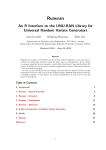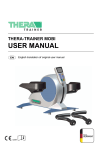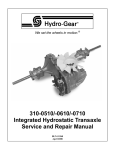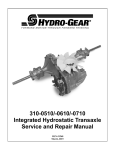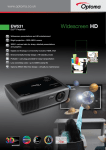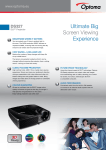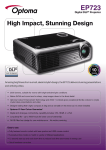Download Dixon ZTR 4515B Repair manual
Transcript
310-2400/2600 Integrated Zero-Turn Transaxle Service and Repair Manual BLN-51134 July, 2011 Table of Contents Section Page Foreword ........................................................................................................................................ 1 Section 1 Description and Operation........................................................................................... 2 Introduction ........................................................................................................................................................ 2 General Description............................................................................................................................................ 2 Hydraulic Schematic........................................................................................................................................... 3 Hydraulic Flow ................................................................................................................................................... 4 External Features 310-2400L ............................................................................................................................. 6 External Features 310-2600R............................................................................................................................. 7 Technical Specifications..................................................................................................................................... 8 Product Identification.......................................................................................................................................... 8 Section 2 Safety ............................................................................................................................. 9 Personal Safety.................................................................................................................................................. 9 Tool Safety......................................................................................................................................................... 9 Work Area Safety ............................................................................................................................................... 9 Servicing Safety ................................................................................................................................................. 9 Section 3 Troubleshooting.......................................................................................................... 10 Section 4 Service and Maintenance ........................................................................................... 11 External Maintenance....................................................................................................................................... 11 Service and Maintenance Procedures .............................................................................................................. 11 Fluids............................................................................................................................................................... 12 Purging Procedures.......................................................................................................................................... 13 Return to Neutral Setting .................................................................................................................................. 14 Brake Maintenance .......................................................................................................................................... 15 Friction Pack Adjustment.................................................................................................................................. 15 Section 5 Repair........................................................................................................................... 16 How To Use This Section ................................................................................................................................. 16 General Instructions ......................................................................................................................................... 16 Transaxle Removal .......................................................................................................................................... 16 Limited Disassembly ........................................................................................................................................ 16 Tools and Torques ........................................................................................................................................... 17 Back Cover ...................................................................................................................................................... 18 Brakes ........................................................................................................................................................ 19-20 Brake Shaft & Bevel Gear ................................................................................................................................ 21 Axle Shaft & Spur Gear ............................................................................................................................... 22-23 Lower Housing and Filter............................................................................................................................. 24-25 Motor Shaft & Bevel Gear................................................................................................................................. 26 Center Section, Cylinder Blocks and Bypass ............................................................................................... 27-28 Input Shaft & Trunnion Arm ......................................................................................................................... 29-30 Transaxle Installation ....................................................................................................................................... 31 Assembly After a Complete Teardown.............................................................................................................. 31 Sealant Application ..................................................................................................................... 32 Parts List .................................................................................................................................34-37 Glossary of Terms ..................................................................................................................38-39 FOREWORD Headquartered in Sullivan, Illinois, HydroGear® is a world leader in the design, manufacture, and service of quality hydrostatic transaxles for the lawn and garden industry. The mission of our company is to be recognized by our customers and the industry as a world-class supplier and the quality leader in everything we do. This Service and Repair Manual is designed to provide information useful in servicing the Hydro-Gear 310-2400, referred to as the Integrated Zero Turn (IZT®), and 310-2600 Charged IZT. Also included is a glossary of terms that are frequently used throughout the industry and in Hydro-Gear service publications. Understanding terminology is very important! It is necessary, and good shop practice, that your service area be equipped with proper tools and the mechanics to be supplied with 310-2400/2600 IZT® the latest information available. All repair procedures illustrated in this guide are suggested, but preferred methods of repair. Some repair procedures require that the IZT be removed from the vehicle. This is not a certification, test or study guide for a certification test. If a technician is interested in certification they should contact an agent representing the ESA (Engine Service Association) (610) 363-3844 or their Hydro-Gear Distributor. Many distributors will be hosting certification testing. These study guides will cover most of the products and manufacturers in our industry. For more information about Hydro-Gear or our products, please contact your Central Service Distributor, or call our Customer Service Department at (217) 728-2581. 1 SECTION 1. DESCRIPTION AND OPERATION INTRODUCTION The purpose of this manual is to provide information useful in servicing the Hydro-Gear® Integrated Zero Turn (IZT®) transaxle. This manual includes the IZT’s general description, hydraulic schematic, technical specifications, servicing and troubleshooting procedures. The transaxle normally will not require servicing during the life of the vehicle in which it is installed. Should other servicing be required, the exterior of the transaxle will need to be thoroughly cleaned before beginning most procedures. GENERAL DESCRIPTION The 310-2400/2600 is a self contained unit designed for the transfer and control of power. It provides an infinitely variable speed range between zero and maximum in both forward and reverse modes of operation. This transaxle uses a variable displacement pump with a maximum displacement of 10cc per revolution, and motor with a fixed displacement of 21cc per revolution. The variable displacement pump features a cradle mounted swashplate with a direct-proportional displacement control. Reversing the direction of the swashplate reverses the flow of oil from the pump and thus reverses the direction of the motor output rotation. The pump and motor are of the axial piston design and utilize spherical nosed pistons which are held against a thrust race by internal compression springs. 2 The 310-2400/2600 has a self contained fluid supply and an internal filter. The 310-2400 fluid is forced through the filter by a positive “head” on the fluid in the housing/expansion tank with an assist by the negative pressure created in the pump pistons as they operate. The 310-2600 fluid is drawn through the internal reservoir and feeds the fixed displacement gerotor charge pump. Excess fluid in the charge circuit is discharged over the charge relief valve and dumps back to case. The check valves in the 310-2400/2600 center section are used to control the makeup flow of the fluid to the low pressure side of the loop. WARNING Actuating the bypass will result in the loss of hydrostatic braking capacity. The machine must be stationary on a level surface and in neutral when actuating the bypass. A bypass is utilized in the 310-2400/2600 to permit moving the vehicle for a short distance at a maximum of 2 m.p.h. (3.2 Km/h) without starting the engine. The 310-2400/2600 is configured for both floating disc and cog style parking brakes. 310-2400/2600 IZT® 310-2400 or or or 310-2600 or or or Figure 1. 310-2400/2600 Hydraulic Flow Schematics 310-2400/2600 IZT® 3 310-2400 CHECK VALVE CYLINDER BLOCK ASSEMBLY CYLINDER BLOCK ASSEMBLY BYPASS ACTUATOR FIXED SWASHPLATE MOTOR SHAFT INPUT SHAFT VARIABLE SWASHPLATE VARIABLE DISPLACEMENT 10cc PUMP FIXED DISPLACEMENT 21cc MOTOR CHECK VALVE RESERVOIR TRANSAXLE HOUSING FILTER 310-2600 CHECK VALVE CYLINDER BLOCK ASSEMBLY BYPASS ACTUATOR CHARGE PUMP INPUT SHAFT CYLINDER BLOCK ASSEMBLY FIXED SWASHPLATE MOTOR SHAFT VARIABLE SWASHPLATE VARIABLE DISPLACEMENT 10cc PUMP FIXED DISPLACEMENT 21cc MOTOR CHECK VALVE RESERVOIR TRANSAXLE HOUSING FILTER Figure 2. 310-2400 /2600Hydraulic Flow Illustration 4 310-2400/2600 IZT® HYDRAULIC SCHEMATIC Figure 2 provides an illustration of the hydraulic oil circuits. The oil supply for the hydraulic system of the 310-2400 IZT® and charged 3102600 IZT is also utilized for lubricating the components of the final drive assembly. The input shaft and pump cylinder block are turned in one direction only by the engine/drive belt/pulley combination. Output of the oil flow is controlled by the direction and amount that the variable swashplate is angled. As the pump pistons compress they force the oil to flow through one of two passageways (forward or reverse) in the center section to the motor cylinder block and motor shaft. Since the motor has a fixed displacement angle it is forced to turn with the flow of oil. As the angle of the pump swashplate is increased the amount of oil being pumped will increase and cause a higher speed output of the motor. Reversing the angle of the swashplate will reverse the direction of oil flow. During the operation of the transaxle, fluid is “lost” from the hydraulic loop through leak paths designed into the product for lubrication purposes (around pistons, under the rotating cylinder blocks, etc.). This “lost” fluid returns to the transaxle housing, then is pulled back into one of the check valves depending upon the direction of vehicle operation. All of this oil must pass through an internal filter. The motor cylinder block mounts onto a splined motor shaft which drives the gear train. A charge pump is included on the IZT to supply this makeup flow. The make up flow is controlled (or directed) by the check valves. Each check valve will either be held opened or closed (depending upon the direction of vehicle operation) by the system operating pressure (closed) or by charge pressure (open) from the charge pump. The charge pump maintains a continuous flow of oil as long as the input shaft is turning. All of the oil being pulled into the charge pump first must pass through an internal filter. Any oil not needed by the transmission for make up flow is discharged through the charge relief valve. The charge relief valve maintains the charge pressure at no more than 40 PSI (2.76 bar). The bypass feature in the 310-2600 has a mechanical lever which lifts the motor block off of the center section running surface, allowing any oil flowing from the pump block to be discharged into the housing without turning the motor. Oil is forced through the filter by low inlet pressure only on the 310-2400, but is pulled by a charge pump circuit on the 310-2600. 310-2400/2600 IZT® 5 EXTERNAL FEATURES 310-2400L Back Cover Back Cover Axle Shaft Disc Brake Assembly Hub Assembly Fill Port Cog Brake Assembly 6 Seal Plug Input Shaft Lower Cover Bypass Actuator Control Arm Assembly 310-2400/2600 IZT® EXTERNAL FEATURES 310-2600R Filter Charge Cover Charge Cover Back Cover Back Cover Axle Shaft Bypass Hub Assembly Filter Charge Cover Bypass Input Shaft Fill Port Oil Drain Filter Control Arm Assembly Charge Cover 310-2400/2600 IZT® Lower Cover Seal Plug Cog Brake Assembly “Only” Charge Cover 7 TECHNICAL SPECIFICATIONS 310-2400 Axle Shaft Options Type: Keyed / Double “D” Diameter: 0.984 inch; 25.0 mm Type: Flanged Diameter: Hub Overall Transaxle Reduction 19.2:1 Input Speeds Maximum: 3000 RPM Minimum: 1800 RPM Tire Diameter 18 in maximum; 45.7cm with 325 lbs; 147.4 kg maximum weight on tires Brake Type Disc, Parking Cog, Parking Weight of Unit 30 lb; 13.6 kg 310-2600 Overall Transaxle Reduction 19.2:1 Axle Shaft Options Type: Keyed / Double “D” Diameter: 0.984 inch; 25.0 mm Type: Flanged Diameter: Hub Input Speeds Maximum: 3400 RPM Minimum: 1800 RPM Tire Diameter 20 in maximum; 45.7cm with 325 lbs; 147.4 kg maximum weight on tires Brake Type Cog, Parking Weight of Unit 31 lb; 14 kg Table 1. 310-2400/2600 Technical Specifications PRODUCT IDENTIFICATION The model and configuration of the 310-2400/2600 IZT® can be determined from the label shown in Figure 3. H Y D R O - G E A R S U L LI V A N , I L . U .S .A . I I III III I III II II M o d el Model Number N u m be r 173808574 8 6 313 3 1 8- -2 2600L 400 318-2600L I II IIII IIII III III I II IIII 03 3 1 9 Z 1 4 0 1 H yHydro-Gear d r o -G e a r Ref. R e f. NNumber umber M a d e in U .S .A . S e ri a l NNumber um b e r Serial number for (u n iq (Unique ue nu m b e r fo r that th a tmodel—for m o d e l -that fo rday) th a t d a y ) YYear e a rBuilt B u ilt DDate a te (Julian—day of year) (Ju li a n - d a y o f y e a r ) T y p e o fType P r oofdProduct u c t a Build n d BInformation u ild In fo r m a t io n Figure 3. 310-2600 Configuration Label 8 310-2400/2600 IZT® SECTION 2. SAFETY This symbol points out important safety instructions which, if not followed, could endanger the personal safety and/or property of yourself and others. Read and follow all instructions in this manual before attempting maintenance on your transaxle. When you see this symbol - HEED ITS WARNING. WARNING POTENTIAL FOR SERIOUS INJURY Inattention to proper safety, operation, or maintenance procedures could result in personal injury, or damage to the equipment. Before servicing or repairing the 310 -2400 IZT, fully read and understand the safety precautions described in this section. PERSONAL SAFETY Certain safety precautions must be observed while servicing or repairing the 310-2400 IZT®. This section addresses some of these precautions but must not be considered an allinclusive source on safety information. This section is to be used in conjunction with all other safety material which may apply, such as: 1) Other manuals pertaining to this machine, 2) Local and shop safety rules and codes, 3) Governmental safety laws and regulations. Be sure that you know and understand the equipment and the hazards associated with it. Do not place speed above safety. Notify your supervisor whenever you feel there is any hazard involving the equipment or the performance of your job. Never allow untrained or unauthorized personnel to service or repair the equipment. clothing or jewelry can be hazardous. Use the appropriate safety equipment, such as eye and hearing protection, and safety-toe and slipproof shoes. Never use compressed air to clean debris from yourself or your clothing. TOOL SAFETY Use the proper tools and equipment for the task. Inspect each tool before use and replace any tool that may be damaged or defective. WORK AREA SAFETY Keep the work area neat and orderly. Be sure it is well lit, that extra tools are put away, trash and refuse are in the proper containers, and dirt or debris have been removed from the working areas of the machine. The floor should be clean and dry, and all extension cords or similar trip hazards should be removed. SERVICING SAFETY Certain procedures may require the vehicle to be disabled in order to prevent possible injury to the servicing technician and/or bystanders. The loss of hydrostatic drive line power may result in the loss of hydrostatic braking capability. Proper brake maintenance is very important should this condition develop. Some cleaning solvents are flammable. Use only approved cleaning materials. Do not use explosive or flammable liquids to clean the equipment. To avoid possible fire do not use cleaning solvents in an area where a source of ignition may be present. Discard used cleaning material in the appropriate containers. Wear appropriate clothing. Loose or hanging 310-2400/2600 IZT® 9 SECTION 3. TROUBLESHOOTING WARNING Do not attempt any servicing or adjustments with the engine running. Use extreme caution while inspecting the drive belt assembly, and all vehicle linkage! Follow all safety procedures outlined in the vehicle owner’s manual! In many cases problems with the 3102400/2600 IZT are not related to a defective transaxle, but are caused by slipping drive belts, partially engaged bypass valves, and loose or damaged control linkages. Be sure to perform all operational checks and adjustments outlined in Section 4, Service and Maintenance before assuming the unit is malfunctioning. Table 2 below provides a troubleshooting check list to help determine the cause of operational problems. Table 2. 310-2400 Troubleshooting Checklist Possible Cause Corrective Action UNIT OPERATES IN ONE DIRECTION ONLY Control linkage bent or out of adjustment Drive belt slipping or pulley damaged Repair or replace linkage, Page 11 Repair or replace drive belt or pulley, Page 11 VEHICLE DOES NOT DRIVE/TRACK STRAIGHT Vehicle tires improperly inflated Control linkage bent, loose or out of adjustment Bypass partially engaged Refer to vehicle manufacturer suggested pressure Repair, adjust or replace vehicle linkage Adjust bypass linkage UNIT IS NOISY Oil level low or contaminated oil Excessive loading Brake setting incorrect Loose parts Bypass assembly sticking Air trapped in hydraulic system Filter clogged with debris Fill to proper level or change oil, Page 12 Reduce vehicle loading, Page 11 Adjust brake to proper setting, Page 15 Repair or replace loose parts Repair or replace valve or linkage Purge hydraulic system, Page 13 Replace filter, Page 12 UNIT HAS NO/LOW POWER Engine speed low Control linkage bent or out of adjustment Brake setting incorrect Drive belt slipping or pulley damaged Oil level low or contaminated oil Excessive loading Bypass assembly sticking Air trapped in hydraulic system Filter clogged with debris Debris buildup around transaxle Brake setting incorrect Cooling fan damaged Oil level low or contaminated oil Excessive loading Air trapped in hydraulic system Adjust to correct setting Repair or replace linkage, Page 11 Adjust brake to proper setting, Page 15 Repair or replace drive belt or pulley, Page 11 Fill to proper level or change oil, Page 12 Reduce vehicle loading, Page 11 Repair or replace valve or linkage Purge hydraulic system, Page 13 Replace filter, Page 12 UNIT OPERATING HOT Clean off debris, Page 11 Adjust brake to proper setting, Page 15 Repair or replace cooling fan Fill to proper level or change oil, Page 12 Reduce vehicle loading, Page 11 Purge hydraulic system, Page 13 TRANSAXLE LEAKS OIL Damaged seals, housing, or gaskets Air trapped in hydraulic system 10 Replace damaged component Purge hydraulic system, Page 13 310-2400/2600 IZT® SECTION 4. SERVICE AND MAINTENANCE NOTE: Any servicing dealer attempting a warranty repair must have prior approval before conducting maintenance of a Hydro-Gear product unless the servicing dealer is a current Authorized Hydro-Gear Service Center. EXTERNAL MAINTENANCE Regular external maintenance of the 310-2400 IZT® should include the following: SERVICE AND MAINTENANCE PROCEDURES All the service and maintenance procedures presented on the following pages can be performed while the 310-2400/2600 is mounted on the vehicle. Any repair procedures as mentioned in the repair section of this manual must be performed after the unit has been removed from the vehicle. 1. Check the vehicle operator’s manual for the recommended load ratings. Insure the current application does not exceed load rating. 2. Check oil level and quality in accordance with Figure 4 Page 12. 3. Inspect the vehicle drive belt, idler pulley (s), and idler spring(s). Insure that no belt slippage can occur. Slippage can cause low input speed to the transmission. 4. Inspect the transmission cooling fan for broken or distorted blades and remove any obstructions (grass clippings, leaves, dirt, etc.). 5. Inspect the axle parking brake and vehicle linkage to insure proper actuation and adjustment of the parking brake. 6. Inspect the vehicle control linkage to the directional control arm on transaxle. Also, insure the control arm is securely fastened to the trunnion arm of the transaxle. 7. Inspect the bypass mechanism on the transaxle and vehicle linkage to insure it actuates and releases fully. 310-2400/2600 IZT® 11 FLUIDS The fluids used in Hydro-Gear® products have been carefully selected, and only equivalent, or better products should be substituted. Typically, an engine oil with a minimum rating of 55 SUS (9 cSt) at 230°F (110° C) and an API classification of SL is recommended. A SAE 20W-50 engine oil has been selected for use by the factory and is recommended for normal operating temperatures. FLUID VOLUME AND LEVEL Fluid volume information is provided in Table 3. Certain situations may require additional fluid to be added or even replaced. Refer to Figure 4 for the proper fill port location. CAUTION Do not overfill. If you overfill the transaxle while the unit is “cold”, it may overflow as it reaches normal operating temperatures. The oil level should not be above the manufacturer’s suggestions outlined in this manual. This will allow the space needed for the oil to expand as it warms up. Recheck the fluid level once the unit has been operated for approximately 1 minute. Purging may be required. Refer to the purging procedures on page 13. FLUID CHANGE The 310-2400 transaxle is factory filled, sealed and does not require oil maintenance. However, in the event of oil contamination or degradation, oil addition or change may alleviate certain performance problems. 310-2600 charged IZT® oil change requirements may vary with usage. But, regular maintenance filter and oil change at 200 hour intervals is recommended. It is essential that the unit exterior be free of debris prior to fluid maintenance. Remove the oil drain plug (87) to facilitate oil change. Refer to figure 14. Page 25. To reinstall oil drain plug reference table 5. for proper torque. IMPORTANT: When tightening the filter insure proper torque value 20-50 in lbs (2-6 Nm) is applied. Filter is plastic. Excessive torque will damage filter. Table 3. Fluid Volumes for the 310-2400/2600 IZT Fluid Description Volume 20W-50 engine oil 79 fl. oz. (2336 ml.) FILL PORT 1⅞" (48.0 mm) OIL LEVEL Figure 4. 310-2400/2600 Fluid Level and Fill Port 12 310-2400/2600 IZT® PURGING PROCEDURES Due to the effects air has on efficiency in hydrostatic drive applications, it is critical that it be purged from the system. These purge procedures should be implemented any time a hydrostatic system has been opened to facilitate maintenance or any additional oil has been added to the system. Air creates inefficiency because its compression and expansion rate is higher than that of the oil normally approved for use in hydrostatic drive systems. The resulting symptoms in hydrostatic systems may be: 1. Noisy operation. 2. Lack of power or drive after short term operation. 3. The following procedures should be performed with the vehicle drive wheels off the ground, then repeated under normal operating conditions. 1. With the bypass valve open and the engine running, slowly move the directional control in both forward and reverse directions 5 to 6 times, as air is purged from the unit, the oil level will drop. 2. With the bypass valve closed and the engine running, slowly move the directional control in both forward and reverse directions (5 to 6 times). Check the oil level, and add oil as required after stopping engine. 3. It may be necessary to repeat Steps 1 and 2 until all the air is completely purged from the system. When the transaxle moves forward and reverse at normal speed purging is complete. High operation temperature and excessive expansion of oil. Before starting, make sure the transaxle/ transmission is at the proper oil level. If it is not, fill to the specifications outlined on page 12, Figure 4. 310-2400/2600 IZT® 13 RETURN TO NEUTRAL SETTING WARNING WARNING POTENTIAL FOR SERIOUS INJURY Certain procedures require the vehicle engine to be operated and the vehicle to be raised off the ground. To prevent possible injury to the servicing technician and/or bystanders, insure the vehicle is properly secured. The return to neutral mechanism on the transmission is designed to set the directional control into a neutral position when the operator removes their hands from the control. Follow the procedures below to properly adjust the return to neutral mechanism on the transaxle: 1. Confirm the transaxle is in the operating mode (bypass disengaged). Raise the vehicle’s drive tires off the ground to allow free rotation. NOTE: It may be necessary to remove the drive tire from the axle hub to access the linkage control and the transaxle return arm. 2. Remove the Original Equipment Manufacturer’s (OEM’s) control linkage at the return arm. Refer to Figure 5. 3. Start the engine and increase the throttle to full engine speed. Do not attempt any adjustments with the engine running. Use extreme caution while inspecting all vehicle linkage! Follow all safety procedures outlined in the vehicle owner’s manual. 4. Check for axle rotation. If the axles do not rotate, go to Step 5. If the axles rotate, go to Step 6. 5. Stop the vehicle’s engine. Reattach and adjust the OEM linkage to the return arm according to the OEM manual. Recheck according to Step 3 and 4. Stop the vehicle engine. Refer to Figure 5. 6. Note the axle directional movement. Stop the vehicle engine. Loosen the lock down screw until the return arm can be rotated. Refer to Figure 5 below to make adjustment. In general, rotate the return arm in the direction opposite of axle rotation. If the axle is rotating in the “B” direction, rotate the return arm in the “A” direction, and vice-versa. Continue until axle rotation stops. Tighten the lock down screw. Refer to Table 5 Required Torque Values, Page 17. Recheck according to steps 3 and 4. Stop the vehicle engine. Reattach and adjust the OEM linkage according to the OEM manual. Recheck according to steps 3 and 4. Refer to Figure 5. AXLE ROTATION “B” LOCK DOWN SCREW AXLE ROTATION “A” RETURN ARM E AXL AXL E IO TAT RO RO TAT IO ” N “A N “B ” Figure 5. Return to Neutral Control 14 310-2400/2600 IZT® BRAKE MAINTENANCE COG BRAKE MAINTENANCE FRICTION PACK ADJUSTMENT 1. Check the brake arm teeth for damage or excessive wear. Replace if necessary. The friction pack dampens or holds the operator control lever in its desired position. 2. Check for excessive looseness at brake arm pivot point. Adjustment for the amount of drag or holding force can be made by turning the friction pack nut in or out. DISC BRAKE MAINTENANCE (310-2400 Only) 1. Remove the brake return spring, and then the cotter pin securing the brake castle nut. 2. Insert a 0.020" (0.5 mm) feeler gage between the brake rotor and outer brake friction stator, and then set the brake by tightening or loosening the castle nut. 3. Install a new cotter pin to secure the castle nut, and then install the brake arm bias spring. Adjustments should be made in no more than 1/4 turn increments. Over-tightening will result in difficulty or inability of the operator to move the control lever. Note: The factory setting for the friction pack is assembly of the nut to 100 in-lbs (11 Nm) torque. The friction pack nut is then backed off per vehicle manufacturer’s specifications. FRICTION PACK ADJUSTING NUT BRAKE ARM TEETH PIVOT CONTROL ARM Figure 7. Friction Pack COG PARKING BRAKE BRAKE SETTING LOCATION DISC PARKING BRAKE Figure 6. Brake Options 310-2400/2600 IZT® 15 SECTION 5. REPAIR HOW TO USE THIS SECTION Each subassembly illustrated in this section is illustrated by an exploded view showing the parts involved. The item reference numbers in each illustration are for assembly instructions only. See pages 34,35,36 and 37 for part names and descriptions. A complete exploded view and item list of the transaxle is provided at the end of this section. Many of the parts and subassemblies of this transaxle can be removed and serviced independently of other components. Where some components and assemblies must be removed before a given assembly can be serviced, that information is given at the beginning of the disassembly instructions. GENERAL INSTRUCTIONS Cleanliness is a primary means of assuring satisfactory life on repaired units. Thoroughly clean all exposed surfaces prior to any type of maintenance. Cleaning of all parts by using a solvent wash and air drying is usually adequate. As with any precision equipment, all parts must be kept free of foreign material and chemicals. Protect all exposed sealing surfaces and open cavities from damage and foreign material. The external surfaces should be cleaned before beginning any repairs. Upon removal, it is recommended that all seals, O-rings, and gaskets be replaced. During installation lightly lubricate all seals, Orings, gaskets with a clean petroleum jelly prior to assembly. Also protect the inner diameter of seals by covering the shaft with a cellophane (plastic wrap, etc.) material. Parts requiring replacement must be replaced from the appropriate kits identified in the Items Listing, found at the end of this manual. Use only original Hydro-Gear replacement parts found on the Hydro-Gear service schematics at www.hydro-gear.com. 16 TRANSAXLE REMOVAL It is necessary to remove the 310-2400/2600 from the vehicle before pe













































